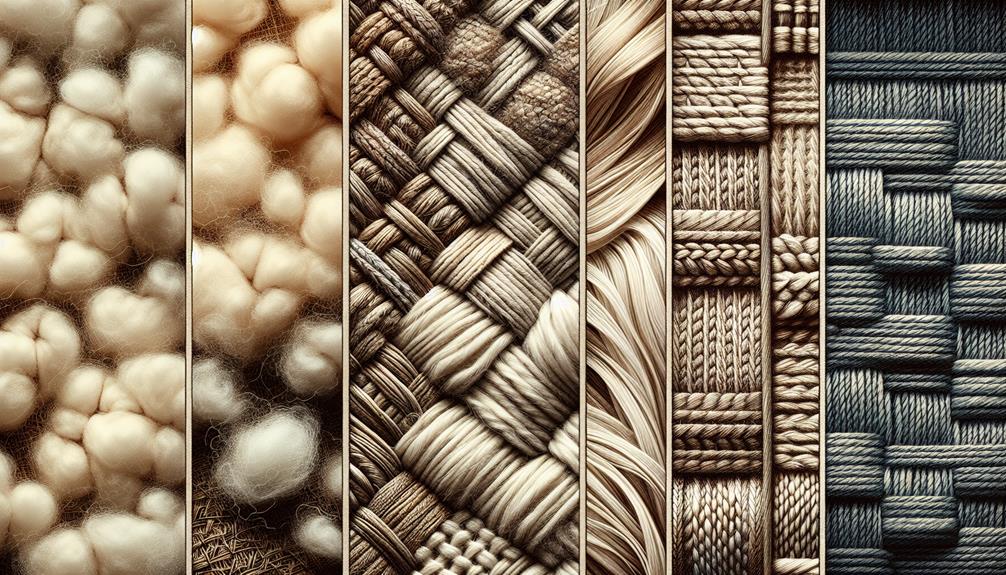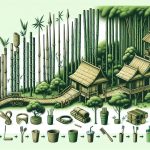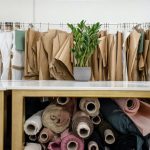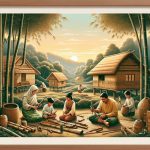I once marveled at a beautifully intricate tapestry made of wool and silk, wondering about the artistry behind it.
The art of weaving encompasses a vast array of materials, each with its own unique qualities and characteristics that contribute to the final product.
From the natural fibers like cotton and wool to the synthetic fibers that have revolutionized textile production, the world of weaving is a tapestry waiting to be explored.
Join me as we unravel the secrets behind what truly makes a material perfect for weaving.
Table of Contents
Key Takeaways
- Natural fibers like cotton, linen, hemp, and bamboo are commonly used for weaving.
- Synthetic fibers such as polyester blends and acrylic offer durability and color retention.
- Wool is a versatile material with natural insulation and moisture-wicking properties.
- Silk is a luxury fiber that elevates weaving with its luxurious qualities and distinct weaving techniques.
Natural Fibers in Weaving
When I weave, I prefer using natural fibers like cotton and linen for their durability and softness. These fibers have been staples in weaving for centuries due to their versatility and comfort.
However, exploring beyond the traditional, I've found that hemp weaving techniques offer a unique and sustainable approach to creating textiles. Hemp fibers are incredibly strong, making them ideal for weaving sturdy fabrics that can withstand daily use. The process of weaving with hemp requires attention to detail but results in beautiful and long-lasting pieces.
Another natural fiber that has caught my attention is bamboo. Bamboo fiber brings a range of benefits to weaving, including its natural antibacterial properties and moisture-wicking abilities. Fabrics woven with bamboo fibers aren't only soft to the touch but also environmentally friendly. Incorporating bamboo into my weaving projects has added a luxurious feel while also aligning with my commitment to sustainable practices.
Exploring these natural fibers and their weaving techniques has truly enriched my craft and allowed me to create textiles that are both beautiful and eco-conscious.
Synthetic Fibers for Textiles
Exploring the domain of textile creation, synthetic fibers offer a vast array of innovative possibilities for weaving projects. When considering synthetic fibers for textiles, two key players come to mind: polyester blends and acrylic fibers. Here's why they're essential:
- Polyester blends: These blends are known for their exceptional durability, making them ideal for textiles that need to withstand frequent use and washing. The combination of polyester with other fibers enhances the overall strength and longevity of the fabric, ensuring that the woven piece remains in top condition for an extended period.
- Acrylic fibers: Acrylic fibers are prized for their remarkable colorfastness, meaning they retain their vibrant hues even after multiple washes. This quality makes acrylic a popular choice for textiles where color retention is critical, such as in outdoor fabrics or garments that experience frequent laundering.
Exploring Wool as a Material
Wool stands out as a versatile and natural material with a rich history in textile production. The benefits of wool are numerous, making it a popular choice for weaving. Wool is known for its natural insulating properties, keeping you warm in winter and cool in summer. Additionally, it has moisture-wicking abilities, drawing sweat away from the body to keep you dry and comfortable. Wool is also odor-resistant and can resist wrinkles, making it a low-maintenance option for clothing.
When it comes to wool weaving techniques, there are several traditional methods that have been used for centuries. One common technique is hand-weaving, where skilled artisans create intricate patterns and designs using wool yarns on a loom. Another technique is felting, where wool fibers are matted together using moisture, heat, and agitation to create a dense fabric. These techniques highlight the versatility of wool as a material that can be manipulated in various ways to create different textures and finishes.
The Versatility of Cotton Weaving
Woven textiles hold a unique place in the world of fashion and design, and cotton weaving, in particular, showcases remarkable versatility in its applications and outcomes. As a weaver working with cotton, I've come to appreciate the many benefits it offers, along with the diverse weaving techniques that can be employed to create stunning pieces.
Here are some key points to ponder:
- Breathability: Cotton is highly breathable, making it perfect for creating lightweight and comfortable textiles, ideal for clothing in warm climates.
- Absorbency: One of the significant benefits of cotton is its absorbency, which allows for vibrant dyeing and printing, resulting in beautifully colored fabrics.
- Durability: Cotton weaving produces durable fabrics that can withstand regular wear and washing, ensuring longevity in the final products.
- Versatility in Weaving Techniques: From plain weave to complex patterns like twill and herringbone, cotton lends itself well to various weaving techniques, enabling the creation of intricate designs and textures.
Exploring the world of cotton weaving opens up a universe of possibilities, where creativity and functionality intertwine seamlessly to produce exceptional textile creations.
Silk: Luxury Fiber in Weaving
Silk, renowned for its luxurious qualities, elevates the art of weaving with its exquisite sheen and smooth texture. When delving into the domain of silk weaving, one must appreciate the intricate techniques and meticulous production process that contribute to its allure.
In the world of silk weaving, artisans employ various techniques to create stunning fabrics. Some notable silk weaving techniques include weft-faced weaving, satin weaving, and chiffon weaving. Each technique results in distinct textures and finishes, showcasing the versatility of silk as a fiber.
| Silk Weaving Techniques | Description |
|---|---|
| Weft-faced weaving | Creates tight, durable fabrics with the weft threads dominating the visible surface. |
| Satin weaving | Produces smooth, lustrous fabrics with a glossy front surface. |
| Chiffon weaving | Results in lightweight, sheer fabrics with a soft drape. |
Moreover, the silk production process involves intricate steps such as silkworm rearing, silk reeling, and dyeing. Understanding these processes sheds light on the craftsmanship and skill required to transform raw silk into luxurious textiles.
Frequently Asked Questions
Can You Weave Materials Other Than Fibers, Such as Metal or Paper?
Yes, I can weave materials other than fibers. Metal weaving involves creating intricate patterns using wire or strips. Paper weaving is a craft where strips of paper are intertwined to form designs. Both techniques offer unique artistic possibilities.
How Does the Weaving Process Differ for Different Types of Fibers?
Weaving processes vary for different fibers. Natural fibers like cotton require careful hand weaving techniques, emphasizing tradition and craftsmanship. In contrast, synthetic fibers often undergo machine weaving, focusing on efficiency and mass production. Each method showcases unique characteristics.
Are There Any Environmental Concerns Associated With the Production of Woven Materials?
Environmental impact of woven materials production is significant. Sustainable practices like using organic fibers, eco-friendly dyes, and reducing water waste are essential. Consumers' demand for transparency drives positive change in the industry towards eco-conscious choices.
What Are Some Innovative Techniques or Technologies Being Used in Modern Weaving Practices?
Innovative techniques in modern weaving practices involve digital looms and sustainable practices like using recycled fibers. These advancements reduce waste and energy consumption while creating intricate designs. Such methods are reshaping the weaving industry for the better.
Are There Any Cultural or Historical Significance Attached to Certain Types of Woven Materials?
Cultural traditions and historical symbolism infuse woven materials with profound significance. These textiles not only reflect the artistry of a community but also carry stories, beliefs, and meanings passed down through generations.
- Why Is Red Velvet Not Red? - April 25, 2024
- How Do You Describe Velvet Fabric? - April 25, 2024
- How Strong Is Velvet? - April 25, 2024








